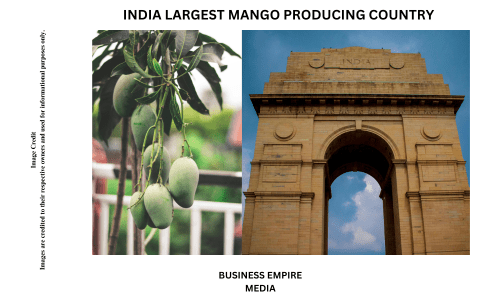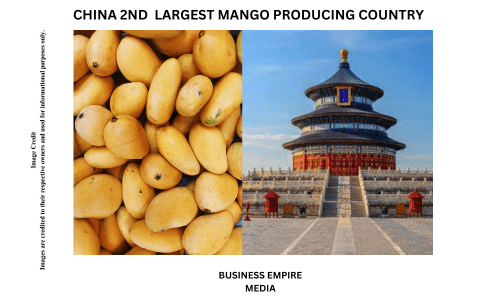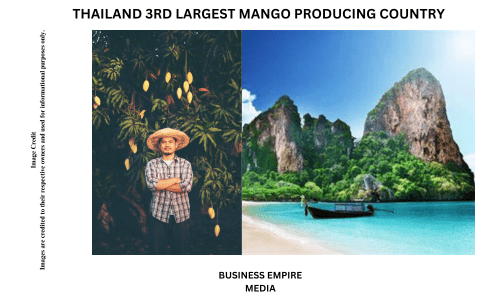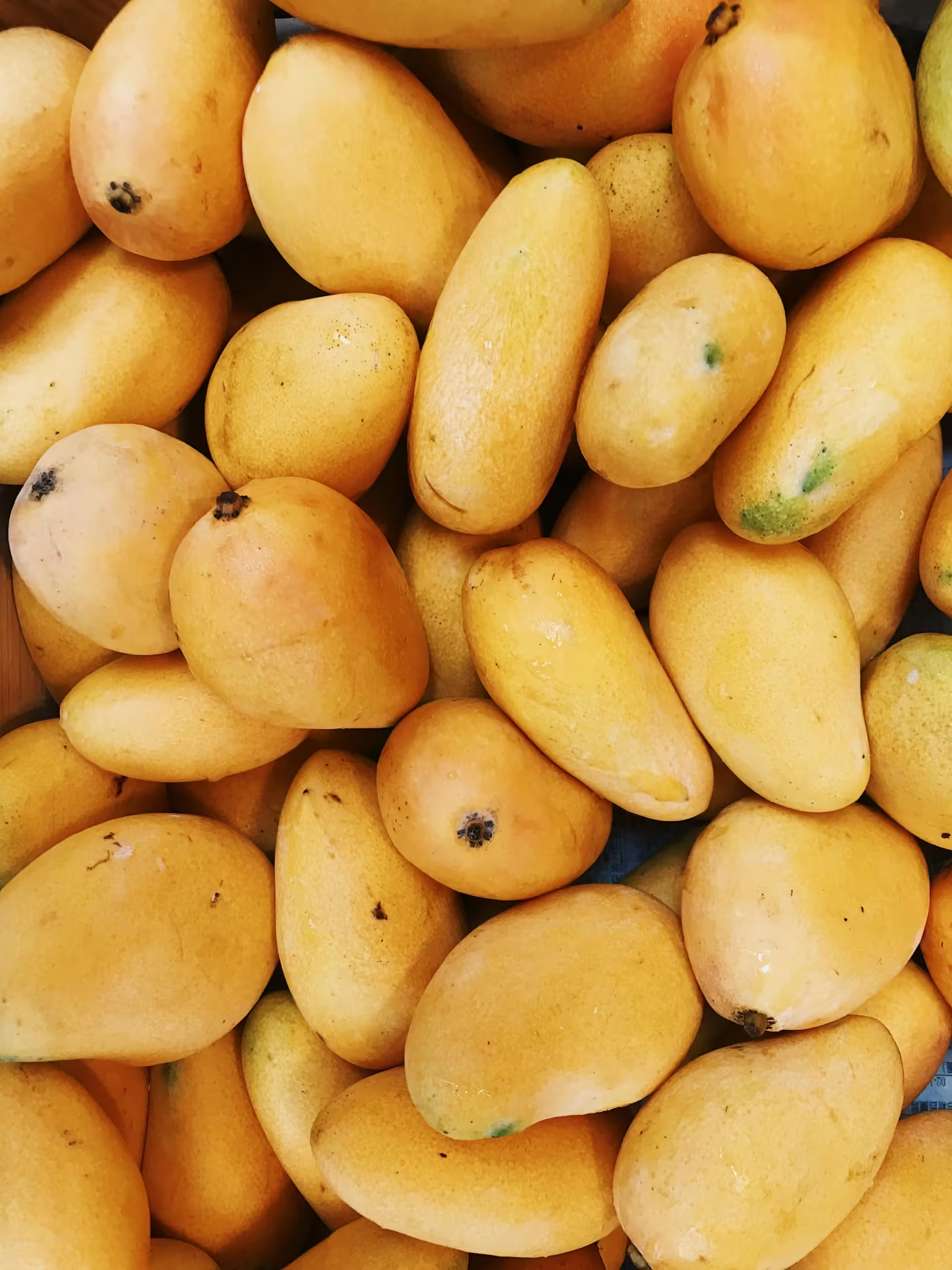Mangoes, often referred to as the “King of Fruits,” are a global favorite, prized for their sweet, juicy flesh and tropical flavor. This luscious fruit, native to South Asia, has spread across the world, thriving in warm, tropical climates. As a result, several countries have become leading producers, contributing to the global mango supply.
Here are some of the Largest Mango Producing Countries in the World
1. India

India is the leading producer of mangoes globally, accounting for around 40-45% of the world’s total mango output. This tropical fruit holds immense cultural and economic significance in the country, with a wide variety of mangoes grown across different regions.
Key Mango Varieties
India is home to a vast array of mango varieties, each with its unique flavor, texture, and aroma. Some of the most famous include:
- Alphonso (Hapus): Known as the “King of Mangoes,” Alphonso is celebrated for its rich, creamy texture and sweet flavor. It is predominantly grown in Maharashtra’s Ratnagiri and Sindhudurg districts.
- Dasheri: This variety is popular for its sweet and tangy taste and is extensively cultivated in Uttar Pradesh, especially in the Malihabad region.
- Banganapalli (Safeda): Widely loved for its firm, juicy flesh, Banganapalli is primarily grown in Andhra Pradesh and Telangana.
- Kesar: Known for its saffron-hued flesh and sweet taste, Kesar is often referred to as the “Queen of Mangoes” and is mainly grown in Gujarat’s Gir region.
- Langra: This variety is famous for its green skin and distinct sweet and sour taste, predominantly cultivated in Varanasi, Uttar Pradesh.
Key Mango Regions
India’s diverse climate allows for mango cultivation in several regions, with the following states being the top producers:
- Uttar Pradesh: The largest mango-producing state, particularly known for Dasheri and Langra varieties.
- Andhra Pradesh: A major producer of Banganapalli and other local varieties.
- Maharashtra: Famous for Alphonso, grown in the coastal districts of Ratnagiri and Sindhudurg.
- Gujarat: Known for Kesar mangoes, especially from the Gir region.
- Karnataka: Produces a variety of mangoes, including Alphonso and Raspuri.
Market Share & Export Value
India dominates the global mango market, supplying a significant portion of the world’s mangoes. In the last fiscal year, India exported over 1.2 million metric tons of mangoes, with a market share of approximately 25% in the global mango export market.
- Export Value: In 2023, India’s mango exports were valued at approximately USD 220 million. Major export destinations included the Middle East, Europe, and the United States, where Indian mangoes are highly sought after.
2. China

China has rapidly emerged as a major player in the global mango market, producing approximately 10-15% of the world’s mangoes. With increasing domestic demand and a strategic focus on agricultural innovation, China has expanded its mango cultivation significantly over the past few decades.
Key Mango Varieties
China cultivates several mango varieties, each selected for its adaptability to the local climate and market preferences. Some of the prominent varieties include:
- Jinhuang: A large, sweet variety with a smooth texture, widely grown in southern China. Jinhuang is popular for its size and deep yellow color.
- Guifei: Known for its fragrant aroma and juicy flesh, Guifei is a favorite in the domestic market and is often enjoyed fresh.
- Keitt: A late-season variety that is known for its sweet and slightly tangy flavor. It is well-suited for both domestic consumption and export.
Key Mango Regions
Mango cultivation in China is concentrated in the southern provinces, where the warm climate is ideal for growing this tropical fruit. The key regions include:
- Guangdong: One of the largest mango-producing provinces, known for its high-quality Jinhuang mangoes.
- Guangxi: A rapidly growing mango region, contributing significantly to China’s overall mango production. The province is known for its fertile soil and favorable climate.
- Hainan: An island province that benefits from a tropical climate, making it an ideal location for mango cultivation. Hainan is known for producing high-quality mangoes that are popular across China.
Market Share & Export Value
China has made significant strides in increasing its share of the global mango market. While much of the production is consumed domestically, China has begun to make inroads into international markets.
- Market Share: China contributes around 10-15% of global mango production.
- Export Value: In 2023, China’s mango exports were valued at approximately USD 150 million. Major export destinations include Southeast Asia, Japan, and the Middle East.
3. Thailand

Thailand is a significant player in the global mango market, known for its high-quality mangoes and extensive cultivation practices. The country produces approximately 4-5% of the world’s mangoes and has established itself as a key exporter of this tropical fruit.
Key Mango Varieties
Thailand is renowned for its delicious and diverse mango varieties. Some of the most popular ones include:
- Nam Dok Mai: Considered one of the best mango varieties in the world, Nam Dok Mai is prized for its sweet, fragrant flesh and smooth texture. It is often referred to as the “queen of mangoes.”
- Keo Savoy: Known for its juicy, sweet flavor and vibrant color, Keo Savoy is widely enjoyed both domestically and internationally.
- Chok Anan: This variety is appreciated for its rich, sweet taste and slightly fibrous texture. It is a popular choice among Thai consumers.
Key Mango Regions
Mango production in Thailand is spread across several regions, each contributing to the country’s reputation as a leading mango producer:
- Central Thailand: This region, including provinces such as Nakhon Pathom and Suphan Buri, is known for its high-quality mangoes and extensive cultivation practices.
- Northeastern Thailand: Provinces like Khon Kaen and Ubon Ratchathani are important mango-growing areas, benefiting from the region’s favorable climate and soil conditions.
- Southern Thailand: The provinces of Surat Thani and Nakhon Si Thammarat are also significant mango-producing regions, known for their diverse mango varieties.
Market Share & Export Value
Thailand’s mango production contributes about 4-5% of the global supply. The country has a strong presence in the international market, with a focus on exporting high-quality mangoes to various regions.
- Market Share: Thailand holds approximately 4-5% of the global mango production market.
- Export Value: In 2023, Thailand’s mango exports were valued at approximately USD 200 million. Major export destinations include Japan, South Korea, China, and various countries in Southeast Asia.
4. Indonesia
Indonesia has emerged as a notable player in the global mango market, contributing approximately 3-4% of the world’s total mango production. The country’s tropical climate and fertile soil create ideal conditions for growing a variety of mangoes that are increasingly sought after both domestically and internationally.
Key Mango Varieties
Indonesia is known for several distinctive mango varieties, each valued for its unique flavor and texture. Some of the prominent varieties include:
- Arumanis: Highly prized for its sweet and aromatic flavor, Arumanis is one of Indonesia’s most popular mango varieties. It is often enjoyed fresh or used in traditional desserts.
- Gedong Gincu: Known for its bright orange flesh and rich, sweet taste, Gedong Gincu is a favorite among consumers and is often used in a variety of culinary applications.
- Harumanis: This variety is noted for its sweetness and aromatic quality, making it a preferred choice for both local consumption and export.
Key Mango Regions
Mango cultivation in Indonesia is concentrated in several regions, each contributing to the country’s reputation as a leading mango producer:
- Java: The island of Java, particularly in provinces such as West Java and Central Java, is a major mango-producing area known for its diverse varieties.
- Sumatra: Mangoes are extensively grown in Sumatra, with regions such as North Sumatra and Lampung contributing significantly to Indonesia’s mango production.
- Bali: Bali also plays a role in mango cultivation, benefiting from the island’s favorable climate for growing high-quality mangoes.
Market Share & Export Value
Indonesia’s mango production represents around 3-4% of global supply. The country has made notable strides in the export market, with increasing interest from international buyers.
- Market Share: Indonesia holds approximately 3-4% of the global mango production market.
- Export Value: In 2023, Indonesia’s mango exports were valued at approximately USD 100 million. Major export destinations include Malaysia, Singapore, the Middle East, and China.
5. Pakistan
Pakistan is a major player in the global mango market, known for its high-quality mangoes and diverse varieties. The country contributes approximately 3-4% of the world’s mango production and has a strong presence in international markets.
Key Mango Varieties
Pakistan is renowned for several premium mango varieties, each celebrated for its distinctive taste and texture. Some of the key varieties include:
- Chaunsa: Often referred to as the “king of mangoes,” Chaunsa is prized for its exceptional sweetness, rich flavor, and creamy texture. It is one of Pakistan’s most famous exports.
- Sindhri: Known for its large size, juicy flesh, and sweet flavor, Sindhri is a popular variety both in domestic and international markets.
- Anwar Ratol: This variety is appreciated for its small size, intense sweetness, and aromatic quality, making it a favorite among mango enthusiasts.
- Langra: Recognized for its green skin and unique sweet-tart flavor, Langra is widely grown and enjoyed across Pakistan.
Key Mango Regions
Mango production in Pakistan is concentrated in several key regions, each contributing to the country’s reputation for high-quality mangoes:
- Punjab: The province of Punjab is the largest mango-producing region, known for varieties like Chaunsa and Anwar Ratol. Key mango-growing districts include Multan, Bahawalpur, and Khanewal.
- Sindh: Sindh is another major mango-producing area, with the province known for its Sindhri mangoes. Key districts include Sukkur and Larkana.
- Khyber Pakhtunkhwa: This region also contributes to mango production, particularly in districts like Dera Ismail Khan.
Market Share & Export Value
Pakistan’s mango production accounts for approximately 3-4% of global mango supply. The country has a significant export presence, with mangoes being a major agricultural export product.
- Market Share: Pakistan holds around 3-4% of the global mango production market.
- Export Value: In 2023, Pakistan’s mango exports were valued at approximately USD 150 million. Major export destinations include the Middle East, Europe, the United States, and Southeast Asia.
6. Mexico
Mexico stands out as a significant player in the global mango market, contributing around 8-10% of the world’s total mango production. The country is known for its high-quality mangoes and has established itself as one of the top exporters of this tropical fruit.
Key Mango Varieties
Mexico is renowned for its diverse mango varieties, each valued for its unique flavor, texture, and color. Some of the key varieties include:
- Ataulfo: Also known as the Honey Mango, Ataulfo is prized for its creamy, buttery texture and sweet, rich flavor. It is one of Mexico’s most popular mango varieties.
- Haden: Known for its vibrant color and tangy-sweet flavor, Haden mangoes are widely grown in Mexico and are popular in both domestic and international markets.
- Kent: This variety is favored for its smooth texture, minimal fibers, and sweet flavor. Kent mangoes are commonly grown in Mexico and are a major export product.
- Tommy Atkins: Recognizable by its red and green skin, Tommy Atkins mangoes have a mildly sweet flavor and are widely cultivated in Mexico for both domestic consumption and export.
Key Mango Regions
Mango production in Mexico is concentrated in several key regions, each contributing to the country’s status as a leading mango producer:
- Sinaloa: A major mango-producing state, Sinaloa is known for its high-quality Ataulfo and Kent mangoes. The region benefits from favorable growing conditions and advanced cultivation practices.
- Michoacán: This state is renowned for its diverse mango varieties, including Haden and Tommy Atkins. Michoacán’s climate and soil conditions are ideal for mango cultivation.
- Nayarit: Nayarit is another important mango-growing region, known for its high-quality mangoes and significant production volumes.
Market Share & Export Value
Mexico’s mango production accounts for approximately 8-10% of global supply, with a strong focus on export markets. The country is one of the top exporters of mangoes worldwide.
- Market Share: Mexico holds around 8-10% of the global mango production market.
- Export Value: In 2023, Mexico’s mango exports were valued at approximately USD 600 million. Major export destinations include the United States, Canada, Japan, and the European Union.
7. Bangladesh
Bangladesh is a significant player in the global mango market, known for its rich variety of mangoes and favorable cultivation conditions. The country produces around 2-3% of the world’s mangoes and is making strides in increasing its presence in the international market.
Key Mango Varieties
Bangladesh is renowned for several high-quality mango varieties, each celebrated for its unique flavor and texture:
- Langra: This variety is widely known for its distinctive sweet-tart flavor and slightly fibrous texture. Langra mangoes are popular both in domestic markets and among international buyers.
- Himsagar: Known for its rich, sweet taste and smooth, fiberless flesh, Himsagar is a favorite variety in Bangladesh and is gaining recognition in international markets.
- Kesar: Although originally from India, Kesar mangoes are also grown in Bangladesh, particularly in regions that mimic the growing conditions of the Indian Kesar variety. They are appreciated for their sweetness and aromatic qualities.
- Chausa: This variety is prized for its exceptional sweetness and creamy texture. Chausa mangoes are popular in Bangladesh and are increasingly being exported.
Key Mango Regions
Mango cultivation in Bangladesh is concentrated in several regions that provide ideal growing conditions:
- Rajshahi: Known as the “Mango Capital of Bangladesh,” Rajshahi is famous for producing some of the country’s best mango varieties, including Langra and Himsagar.
- Dinajpur: This region is another important mango-growing area, known for its high-quality mangoes and significant production volumes.
- Kushtia: Located in the southwestern part of Bangladesh, Kushtia is known for its diverse mango varieties and contributes significantly to the country’s mango production.
Market Share & Export Value
Bangladesh’s mango production accounts for approximately 2-3% of global mango supply. The country is working to increase its export footprint and expand its presence in international markets.
- Market Share: Bangladesh holds around 2-3% of the global mango production market.
- Export Value: In 2023, Bangladesh’s mango exports were valued at approximately USD 70 million. Major export destinations include the Middle East, Europe, and neighboring countries such as India.
8. Brazil
Brazil is an important and growing participant in the global mango market, contributing approximately 2-3% of the world’s mango production. The country’s diverse climatic conditions and advanced agricultural practices support its development as a significant mango producer and exporter.
Key Mango Varieties
Brazil cultivates several mango varieties that are prized for their unique flavors and characteristics. Key varieties include:
- Tommy Atkins: Known for its vibrant red and green skin and mildly sweet flavor, Tommy Atkins is one of Brazil’s most widely grown and exported mango varieties.
- Palmer: This variety is appreciated for its large size, smooth texture, and sweet flavor. Palmer mangoes are popular in both domestic and international markets.
- Haden: Recognized for its tangy-sweet flavor and colorful skin, Haden mangoes are grown in various regions across Brazil and are increasingly featured in export markets.
- Keitt: Known for its late-season availability, Keitt mangoes are valued for their juicy flesh and slightly tangy taste, making them a staple in Brazil’s mango production.
Key Mango Regions
Brazil’s mango production is concentrated in several regions that offer favorable growing conditions:
- Northeast Brazil: This region, including states such as Bahia and Pernambuco, is a major mango-producing area. The tropical climate and advanced irrigation techniques contribute to high-quality mangoes.
- North Brazil: In states like Pará and Maranhão, mango cultivation benefits from the region’s ample rainfall and warm temperatures.
- Central-West Brazil: This region, including Goiás and Mato Grosso, also plays a role in mango production, particularly in areas with suitable growing conditions and modern agricultural practices.
Market Share & Export Value
Brazil’s mango production accounts for approximately 2-3% of global mango supply. The country has been increasing its focus on export markets and enhancing its global presence.
- Market Share: Brazil holds around 2-3% of the global mango production market.
- Export Value: In 2023, Brazil’s mango exports were valued at approximately USD 150 million. Major export destinations include Europe, the United States, and the Middle East.
Export Challenges & Opportunities
Brazil faces challenges such as competition from other major mango-producing countries and navigating complex international trade regulations. However, there are opportunities for growth by improving export quality, expanding into new markets, and leveraging trade agreements to enhance global trade relations.

